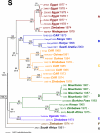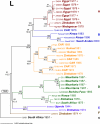Complete genome analysis of 33 ecologically and biologically diverse Rift Valley fever virus strains reveals widespread virus movement and low genetic diversity due to recent common ancestry
- PMID: 17192303
- PMCID: PMC1865992
- DOI: 10.1128/JVI.02095-06
Complete genome analysis of 33 ecologically and biologically diverse Rift Valley fever virus strains reveals widespread virus movement and low genetic diversity due to recent common ancestry
Abstract
Rift Valley fever (RVF) virus is a mosquito-borne RNA virus responsible for large explosive outbreaks of acute febrile disease in humans and livestock in Africa with significant mortality and economic impact. The successful high-throughput generation of the complete genome sequence was achieved for 33 diverse RVF virus strains collected from throughout Africa and Saudi Arabia from 1944 to 2000, including strains differing in pathogenicity in disease models. While several distinct virus genetic lineages were determined, which approximately correlate with geographic origin, multiple exceptions indicative of long-distance virus movement have been found. Virus strains isolated within an epidemic (e.g., Mauritania, 1987, or Egypt, 1977 to 1978) exhibit little diversity, while those in enzootic settings (e.g., 1970s Zimbabwe) can be highly diverse. In addition, the large Saudi Arabian RVF outbreak in 2000 appears to have involved virus introduction from East Africa, based on the close ancestral relationship of a 1998 East African virus. Virus genetic diversity was low (approximately 5%) and primarily involved accumulation of mutations at an average of 2.9 x 10(-4) substitutions/site/year, although some evidence of RNA segment reassortment was found. Bayesian analysis of current RVF virus genetic diversity places the most recent common ancestor of these viruses in the late 1800s, the colonial period in Africa, a time of dramatic changes in agricultural practices and introduction of nonindigenous livestock breeds. In addition to insights into the evolution and ecology of RVF virus, these genomic data also provide a foundation for the design of molecular detection assays and prototype vaccines useful in combating this important disease.
Figures




References
-
- Anderson, G. W., Jr., W. Lawrence, J. O. Lee, and William C. Hall. Ocular sequelae associated with Rift Valley fever virus (RVFV) infection in inbred rat strains. Abstr. VIIIth Int. Congr. Virol., abstr. P70-002.
-
- Anderson, G. W., Jr., and C. J. Peters. 1988. Viral determinants of virulence for Rift Valley fever (RVF) in rats. Microb. Pathog. 5:241-250. - PubMed
-
- Anderson, G. W., Jr., J.-F. Saluzzo, T. G. Ksiazek, J. F. Smith, W. Ennis, D. Thureen, C. J. Peters, and J.-P. Digoutte. 1989. Comparison of in vitro and in vivo systems for propagation of Rift Valley fever virus from clinical specimens. Res. Virol. 140:129-138. - PubMed
-
- Aquino, V. H., M. L. Moreli, and L. T. Moraes Figueiredo. 2003. Analysis of oropouche virus L protein amino acid sequence showed the presence of an additional conserved region that could harbour an important role for the polymerase activity. Arch. Virol. 148:19-28. - PubMed
-
- Beaty, B. J., D. R. Sundin, L. J. Chandler, and D. H. Bishop. 1985. Evolution of bunyaviruses by genome reassortment in dually infected mosquitoes (Aedes triseriatus). Science 230:548-550. - PubMed
Publication types
MeSH terms
Substances
LinkOut - more resources
Full Text Sources
Other Literature Sources
Molecular Biology Databases

